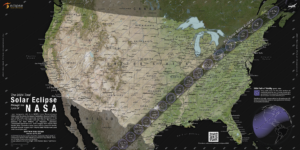Solar eclipse to be visible from bay area Monday
A cross-section of the United States, from Texas to Maine, will be directly underneath Monday’s total solar eclipse, a celestial phenomenon during which the Moon passes directly between Earth and the Sun, completely obscuring (for about three minutes) its light. Those states experiencing complete darkness, and a drop in temperature, are in what scientists call “the path of totality.”
Florida, unfortunately, is far south and east of this path, making the total eclipse unviewable. It will, however, be possible to observe a partial eclipse, about 60 percent, from parts of the Sunshine State, including the Tampa Bay Area.
“Every few years there’s usually a total eclipse somewhere,” said Dr. Craig Joesph, planetarium director at St. Petersburg College, “so it’s not a rare event in terms of frequency. But it’s rare to see it, because you have to be at just the right place.”
The Moon’s shadow, he explained, is several hundred miles wide. “The track of that shadow path is very narrow, so you’re just unlikely to be in the shadow path.
“And it’s even rarer for the shadow path to pass over populated areas. Most of the earth is unpopulated. So typically you have to go out to the middle of the Indian Ocean or something like that to see the eclipse.”
It might be 20 years before inhabited North America can again witness a total solar eclipse.
From St. Petersburg, the partial eclipse will last about 2 hours and 30 minutes from first blush to the end. According to NASA, it will start at 1:43 p.m. and reach its peak at one minute before 3. By 4:14, things will be completely normal again.
It’s important not to look directly at the Sun – at any time, and moreso during an eclipse, where the light doesn’t appear to be so intense (it’s deceptive).
“You do have to have a specialized filter that filters out the harmful, invisible infrared rays,” Joseph said. “That’s what damages your eye; it’s not the brilliance of The Sun.”
The American Astronomical Society lists approved products (temporary glasses, pinhole cameras and other devices) for safely viewing the eclipse, many available at retail. Look for this designation: ISO 12312-2.
According to the website: “Ordinary sunglasses (or multiple pairs of sunglasses), neutral density or polarizing filters (such as those made for camera lenses), smoked glass, photographic or X-ray film (unexposed, exposed, or developed), “space blankets,” potato chip bags, DVDs, and any other materials you may have heard about for solar viewing are NOT safe.”
Public activities Monday, April 8
Noon: Free eclipse-viewing glasses available for the first 2,500 people at the Visit St. Pete/Clearwater booth at the Sugar Sand Festival, on Clearwater Beach’s Pier 60.
https://www.visitstpeteclearwater.com/event/sugar-sand-eclipse-party/53291
1:30 p.m.: Viewing at the St. Petersburg College Planetarium, St. Petersburg/Gibbs campus, near the Natural Science building. Eclipse viewers and specially equipped telescopes will be available in the “quad” area.
https://www.spcollege.edu/friends-partners/about/locations/community-enrichment-facilities/planetarium
2:45 p.m.: Great Explorations Children’s Museum will organize a group viewing at Crescent Lake Park.
https://greatex.org/event/solar-eclipse-day/

NASA map showing the “path of totality” over North America.







